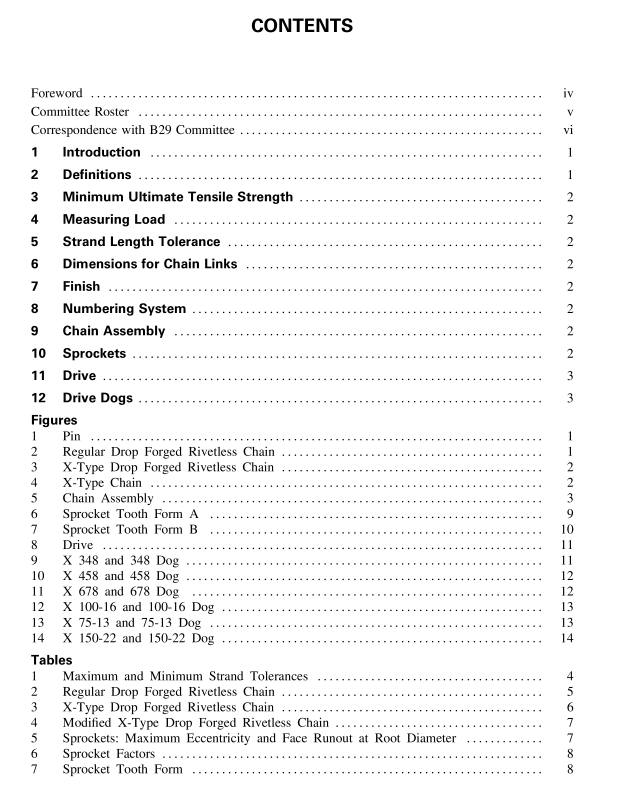ASME B29-22 pdf download

ASME B29-22 pdf download DROP FORGED RIVETLESS CHAINS, SPROCKET TEETH DRIVE CHAIN/DRIVE DOGS
1 INTRODUCTION
The drop forged rivetless chain has widespread use in many industries on trolleys, scraper flights, assembly, and similar conveyors. Because materials do not tend to pack in its open structure, the drop forged rivetless chain is used extensively for flight conveyors. Its design permits both horizontal and vertical operation over irregular routes, making it particularly acceptable for trolley conveyor service.
2 DEFINITIONS drop forged rivetless chain: chain made from drop forged steel parts that are heat treated and are propor- tioned for high strength and comparative light weight. Its simple design permits assembly or dismantling by hand and this chain is available in three general types as illustrated and described (see regular drop forged rivetless chain, X-type chain, and modified X-type riv- etless chain). Numerous attachments are available to suit a wide variety of applications including trolley conveyor service.
pin: part forged symmetrically with T-heads on both ends that lock into the sidebars (see Fig. 1). regular drop forged rivetless chain: chain used for general applications where minimal side flexing is required (see Fig. 2). Attachments are available for mounting on center links or on extended pins. sidebar: part made with a center panel that acts as a shield to reduce material falling through the link and provides strength. The center panel is provided with a center drainage hole (see Fig. 3).
X-type chain: chain with greater side-flexing capabili- ties compared to regular chain (see Figs. 3 and 4). modified X-type rivetless chain: chain with the same feature as X-type (see Fig. 4); additionally, modified X-type has a controlled area, C, on the center link that helps prevent movement of attachments, which may be mounted to the center link (see Fig. 5, dimension C.)
3 MINIMUM ULTIMATE TENSILE STRENGTH
Minimum Ultimate Tensile Strength (M.U.T.S.) for chains covered by this Standard, is the minimum force at which an unused, undamaged chain could fail when subjected to a single tensile loading test.
(a) WARNING: The minimum ultimate tensile strength is NOT a “working load.” The M.U.T.S. greatly exceeds the maximum force that may be applied to the chain.
(b) Test procedure. A tensile force is slowly applied, in uniaxial direction, to the ends of the chain sample.
(c) The tensile test is a destructive test. Even though the chain may not visibly fail when subjected to the minimum ultimate tensile force, it will have been dam- aged and will be unfit for service.
The values adopted for this Standard are for heat- treated medium carbon steel chain only. Medium carbon steels not in the heat-treated condition are not covered by this Standard. Chains produced of other materials not covered in this Standard (alloys, stainless steel) or by casting or fabricating will also have significantly different values of M.U.T.S.
4 MEASURING LOAD The measuring load is determined as five times the weight of a 10 ft strand rounded to the nearest 100 lb. This value is then converted to kilonewtons for the metric equivalent.
5 STRAND LENGTH TOLERANCE
The length of new chains subjected to the specified measuring load must fall within the plus and minus tolerances shown in Table 1. Specific maximum and minimum strand lengths are shown in Tables 2, 3, and 4 for each chain. Maximum and minimum strand tolerances for the given number of pitches in a measuring strand are shown in Table 1.
6 DIMENSIONS FOR CHAIN LINKS To assure interchangeability of links as produced by different makers of chains, standard maximum and minimum dimensions are adopted. They are not actual dimensions used in manufacturing, but limiting dimen- sions, maximum or minimum, required to assure the desired interchangeability. The metric equivalent dimensions are for reference only.
7 FINISH Sharp edges and protrusions shall be absent from the pin seating and driving face areas of the center link.









